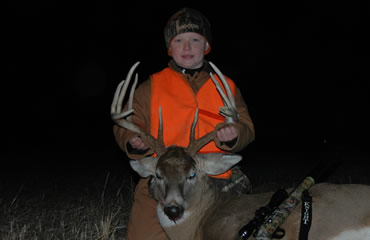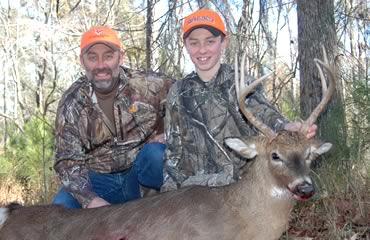The ins and outs of introducing youngsters to deer hunting.
Would it be all right if I hung this on your game pole for a couple days?”
The question came from my friend and hunting companion after we’d finished loading his buck in the back of my truck. “Sure, that’s no problem,” I answered, “but why not just take it to your house?”
He looked at me sort of sheepishly, then reluctantly admitted, “My wife won’t let me take it home. She doesn’t want the kids to see a dead animal.”
I looked at him with my jaw hanging open for a minute and then shook my head. Bagging a deer was something he should have been proud of, something he could celebrate with his family. Instead, he was resigned to shielding it from them as if he’d done something wrong. And people wonder why the number of young hunters is declining.
Adult mentoring programs are great, but their effect on boosting hunter numbers is probably minimal, and most certainly not going to stem the tide. If we want to preserve the proud tradition of hunting, we need to pass it on to the next generation, and there’s no time to lose.
 START ’EM YOUNG
START ’EM YOUNG
The process should start at a very young age. Before my kids were even old enough to walk, I’d let them crawl on the deer I brought home, run their fingers through the fur and poke the eyes. Whether it has fins, fur or feathers, kids are fascinated with eyes. Every time Daddy brought home a buck, turkey or even a brace of woodcocks, it was cause for celebration. And I spared them no gore.
I downed a buck late one afternoon, and the recovery time made me late for picking up my kids from daycare. After tagging the deer, I let it lay while retrieving my pre-school aged youngsters. When we got home, I told them we were going on an adventure and to put on their warm clothes.
The walk into the dark woods by flashlight was pretty exciting, but the real adventure began when we had to “hunt” for the downed buck. After a brief admiration of the fallen deer, they held the lights for the field-dressing. My son was fascinated by the entrails, so I gave him a brief anatomy lesson. My daughter was a bit more reticent, and when I finally looked up at her she was dutifully holding a flashlight in one hand and her nose with the other. She never complained, but later admitted the smell “grossed her out.”
When Daddy or Mommy brings home game, you should make it a positive experience. You can make it a big deal and celebrate as we do, or at the very least, act as though it’s a part of life, like planting a garden in the spring or raking leaves in the fall. If you shelter them from it you’re only telling them there’s something wrong with what you did. “Daddy killed a deer, but don’t tell anyone.” Yes, you’ve taken a life, an action that should be taken seriously. But that lesson will come later, when the kids get older. For now, just let them be kids. Expose them to it without forcing it on them. If they’re interested in getting more involved, they’ll let you know.
MAKE IT FUN
When a kid wants to get involved with the outdoors, make sure it’s fun. Like most parents, I started by taking my kids fishing — nothing fancy, just a worm and a bobber. As they got older, I occasionally took them on hunts, being careful to pick days when the weather was mild and the hunt wasn’t interfering with sleep-overs, soccer games or anything else that occupies busy little lives.
The first time I took my daughter was on a turkey hunt. I called in a gang of jakes, and she got to witness them strutting, gobbling and sparring at super close range for 15 minutes. The whole time, that little 8-year-old girl sat stock still. When they finally drifted off, I asked her, “How cool was that?”
She hesitated for a moment, then admitted, “I was afraid they’d see me, so I closed my eyes.”
We both had a good laugh over that. It was still prime time, and the birds were active that morning, but my daughter was cold and hungry. We left the woods for a muffin, some hot cocoa and some quality father-daughter time.
My son’s first tagalong was a deer hunt. We’d invested a couple hours of sitting still and quiet in hopes it would pay off. That magical twilight period when the deer start to stir was upon us when I looked over and noticed him shivering. “You cold?” I asked, not for the first time that afternoon. This time, he grudgingly admitted that he was. I pondered the situation for a moment and then asked, “You wanna go in?” A quick nod told me our hunt was over. Had we stayed, I might have shot a deer, but I also might have lost a hunting partner.
Sometimes you need to create excitement and put a positive spin on potential negatives.
My daughter got to see a buck up close and personal on one of her first deer hunts. It was in those waning moments of daylight when I spotted the buck coming toward us on a dead still evening. I wanted to see which way the deer would approach, left or right, before getting my daughter in position for the shot. Instead, he came straight in, catching us totally off guard.
An experienced hunter could have pulled off the shot, but not a 10-year-old girl. The buck caught her movement and bolted. I could tell she was disappointed, so I made a point of emphasizing how exciting it was to have a buck so close and never mentioned the missed opportunity.
 TEACH YOUR CHILDREN WELL
TEACH YOUR CHILDREN WELL
Over the course of almost any hunt, there is always at least one teachable moment, and you should never pass up an opportunity.
It was my son’s first deer season, and after a morning on stand we decided to go for a stroll. We jumped several deer, and after the excitement of the moment passed, I quizzed him, “Why where those deer there? Which way did they come from? Why did they let us get so close? Do you think this would be a good place to put a stand?”
The following summer, I put up a ladder stand while he cut shooting lanes. That fall, he killed his first deer when she stood up out of her bed at 75 yards.
Involve them in the process. Don’t just teach them how to kill a deer; teach them how to hunt deer. Kids are like sponges for knowledge, and it’s surprising how much they pick up and retain. I’m constantly pointing stuff out to my kids when they’re in the woods, although I sometimes wonder if they’re really paying attention. Then they catch me off guard by noticing a fresh rub or an unusually large deer track.
Speaking of education, school is such an important part of any kid’s life that you should figure it into the hunting equation whenever possible. My wife and I make it clear that class work and homework come before hunting, but we also try to find ways to integrate them all.
We are fortunate that our school system views hunting not only as acceptable, but as a positive experience. Teachers encourage kids to write about their hunting adventures in literature class, and everybody’s first deer makes the morning announcements. I also look for ways to tie hunting into their school work. An explanation of rifle calibers is a great way to teach fractions, and you can use trajectory to teach geometry and physics.
LET THEM GROW
Very early in his third deer season, my son and I were perched in the very same stand where he’d killed his first deer the year before. Things were kind of slow until a young doe appeared on the scene and slowly ambled our way. I stuck my finger in my ear and, half cringing, waited for the shot that never came. The little doe came almost within spitting distance before wandering off.
The questioning look on my face said it all, and the answer came voluntarily. “It was too small,” my son said. “I didn’t want to shoot it.”
I was flabbergasted. In a state where it’s very possible you’ll only get one chance a season to get a deer, this 12-year-old just passed one up. I was beaming with pride — although I’d have been no less proud had he pulled the trigger. He made that decision on his own, and it was quite exceptional for someone his age.
One of the classic studies of hunter development, and part of every hunter safety curriculum, deals with the five stages of a hunter. Kids like to shoot, and they like to shoot a lot. They also want, and need, to realize some measure of success early on, otherwise they’ll lose interest. Killing a deer, any deer, is validation for their efforts. And for a kid, especially, any deer really is a trophy.
Most states now have special youth hunts that precede the regular season and offer better odds for success. Where they’re implemented, mandatory antler restrictions usually don’t apply to junior hunters.
As they grow older, kids might want to try different methods, like bowhunting or muzzleloading. Give them the opportunity, but let them decide when they’re ready.
Sportsmanship and ethics should be taught, but young hunters should never feel pressured into passing up legal game because it’s too small or somehow inadequate.
It’s also important to realize kids mature at different rates. Some are ready to hunt at 8 or 10 while others aren’t comfortable or confident enough until they’re older. Again, they’ll let you know when they’re ready, but if they can’t handle a firearm comfortably and confidently, they’re not ready.
FINALLY
Hopefully my advice doesn’t sound preachy. I’ve offered my experiences not as the way, but as one way to introduce kids to hunting. It might not be the best way or the right way for every kid, but it’s worked for me so far.
We all need to be good examples for the next generation of hunters by being safe, respectful and reverent of the game we pursue and the avocation we are so passionate about.
Read Recent Articles:
• 10 Last-Ditch Deer Tricks: Because it ain’t over until it’s over!
• How Far Is Too Far? Don’t confuse lab potential with real world conditions when hunting with a slug-shooter.
• Home on the Range: Do bucks really live their lives in one square mile?
This article was published in the August 2011 edition of Buckmasters Whitetail Magazine. Subscribe today to have Buckmasters delivered to your home.